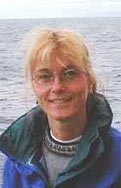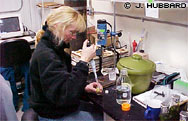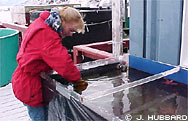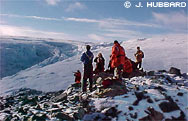| [Editor's Note: This is the first journal entry by UAB Postdoctoral student Katrin Iken. To learn more about her and other members of the UAB in Antarctica team, click on the "crew" button.] How often do I hear comments from my colleagues that the seaweeds I am working with have a bad smell (they use more powerful words, even though the animals most of them work with smell worse). Or they ask if I am preparing the salad for lunch. So I guess it is time to let everybody know what we are doing with these beautiful macroalgae. Macroalgae are an important part of our current project, and we are looking to see if they are chemically defended against herbivores. Herbivores are animals that feed on macroalgae. This can include snails, sea urchins, amphipods (little crustaceans), fish, and many other animals. We want to test the hypothesis that the algae deter these predators using defensive chemicals. That is the background, but what does the actual work look like? It starts of course with the collection of the algae. At the depths that we are diving (usually from around 100 feet upwards) the hard bottom is covered with macroalgae. While diving we can sometimes see nothing other than algae, some of them long, blade-like and laying flat, others branched and erect, and others everything possible in between. We find green, red, and brown algae here. There are more species of the latter two groups, and those two are also dominant in biomass. During the dives I usually try to collect as many different species as possible. However, we also need a certain amount of individual species to work with (Bill Baker, the chemist of our group, always calls for at least one kilogram). So I also try to get a fair amount of whatever algal species is dominant at the spot we are diving that day. The different algal species are not equally distributed everywhere -- that would make things too easy for us! Most species are limited to certain depths, some occur only deep, like the conspicuous brown alga Cystosphaera, which we are particularly interested in. Others are only in the shallow, while many of them prefer either very still water or a lot of current for their growth. When we return from the dive the “real” work begins. That means the sorting and processing of the samples. Sorting means that we have to know the species we are looking at. We know most of the algal species already and those species we sort, weigh to get the biomass, and then freeze for later extraction. That procedure can take a long time, since not all “macro”algae are really big. It can take hours and very cold fingers to sort out little bits and pieces. However, we also have a few species which we do not know yet. Those we try to identify with some identification keys and algal taxonomy literature. Still, a few are hard to identify and give us quite some headaches. Especially from those, but also for most others, we have to make voucher species – that means a sample which is preserved so we can look at it later or ask a specialist to help us identify. For algae, we do not only preserve a piece in formalin as it is usually done with animals. We also make a herbarium sheet. This is usually my work for the late evening after all the sorting, and the best thing is: it can be done in the warmth! I take the wet alga out of the water and put it on a piece of paper, which is a little thicker than usual. I put blotting paper below and on top of this to absorb the water, and separate different sets of algal sheets with cardboard. We can prepare 8 to 10 sheets at a time. The outer layers of the complete set are wood to equalize the pressure which we apply by very tight bands going around the so called herbarium press. We leave the algae in there a few days until they are dry, but I have to exchange the blotting paper each day. Dry algae will stick to the paper, and show many details that are important for their identification. So, I don’t know if macroalgae rule THE world, but for sure they rule MY world while we are down here at Palmer Station! |




